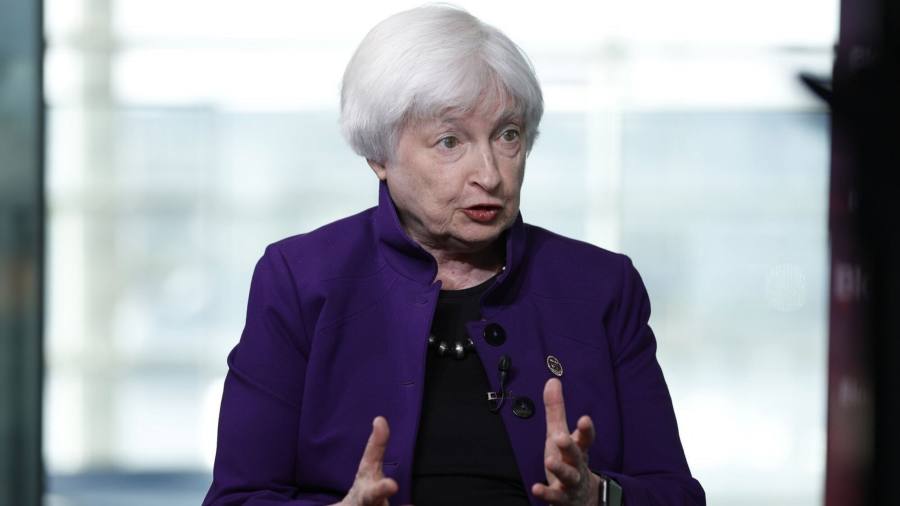The writer is a professor of economics and finance at Columbia University and was chair of the US Council of Economic Advisers under President George W Bush
To “hit the ceiling” is to be frustrated enough to be mad. Just last week, Treasury Secretary Janet Yellen informed Congress and the public that the US Treasury, the world’s biggest borrower, may be unable to meet all of the government’s spending obligations by June 1, raising the spectre of a first-ever default on Treasury debt. The culprit is the “debt ceiling’ — that is, the government has to periodically raise the amount of allowable debt outstanding, a feature of US fiscal affairs since 1917.
The drama has two parts — the surface question of whether the debt ceiling will be raised to accommodate borrowing that reflects spending decisions (whether to pay our bills) and the underlying question of how to alter the nation’s unsustainable fiscal trajectory (whether to agree on a framework for sound policy). Republicans have passed a bill allowing for the debt ceiling to be raised, but with tough conditions not acceptable to the Biden administration. The president and Yellen have called for a “clean” extension with no negotiation. A meeting between Biden and House Speaker Kevin McCarthy produced little momentum.
This looming game of chicken yields a range of reactions from “What’s the debt ceiling?” to “They’ve always worked it out, so they will again” to “This could get ugly”. Well, it could well get ugly, but it doesn’t have to. While the Biden administration is correct that a blow-up leading to a default would be a disaster, a “no negotiation” stance makes achieving any political bargain very difficult. And while House Republicans passed a debt ceiling bill linked to some reasonable spending changes (such as returning unspent Covid outlays), their inclusion of a range of policies beyond this spending debate makes negotiation difficult.
Bringing long-term debt issues to a head by threatening default is calamitous. Even the prospect threatens the cost of credit not only to the federal government, but to US states, businesses, and households. Because such an argument carries irresponsible consequences, it is both a bad experiment and a weak negotiating position. That said, we can’t just keep raising the debt ceiling without consideration of the underlying challenges. The nation is on an unsustainable fiscal path, magnifying future pain.
There is a better way. Understanding consequences of excessive federal deficits and debt is essential in shaping consensus for action on spending and taxes. An agreed-upon fiscal framework could give Congress and the president targets for spending, deficits and debt. This in turn could foster accountability, by giving political actors and the media opportunities to criticise inaction.
Good advice on how to achieve this comes from unlikely places. For conservatives in Congress, Sweden offers a path forward. In response to its own fiscal crisis in the 1990s, Sweden initiated a medium-term budget process beyond the annual budget — with targets for debt and a ceiling on expenditure. The Swedish Fiscal Policy Council provides an independent evaluation of fiscal sustainability, visible to the public and to which the government must respond.
A decade ago, Tim Kane and I proposed a spending limit for the US linked to a long-term average of federal revenue (adjusted for inflation), triggering Congressional action to reduce spending or to raise taxes if large deficits persist. Congress could only override it with a supermajority. The precise mechanism is less important than Sweden’s intuition that a longer-term fiscal framework and direct accountability are needed. Such a mechanism separates worries about debt from the issue of the debt ceiling. Adhering to the budget framework allows future clean increases in the debt ceiling as long as the framework is in place. This would be an advance over our present stand-off and adding near-term spending restraint offers a win for McCarthy.
As for progressives? Good advice here comes from . . . Joe Biden. In the 1970s, then Senator Biden introduced a bill that would have limited budget authority for all federal programmes to between four and six years. He also supported the social security benefit reductions under the 1983 reforms. The point is not that the focus should be on social security or that any framework is perfect, but that a forward-looking target for spending and debt with accountability is important. Moving forward with debt ceiling increases within a budget framework offers a win for Biden.
Consider the alternatives. Flirting with default will prompt an immediate, costly drop in stock prices and confidence in an already weakening economy. (Memo to Congress and the White House: study market reactions to the initial failure to approve the Troubled Asset Relief Program for banks at the onset of the 2008 financial crisis.) And simply acquiescing to a debt ceiling increase with no framework for fiscal sustainability is a prescription for unnecessary future pain. As the late economist Herb Stein once quipped, “If something cannot go on forever, it will stop.”
Read the full article here




